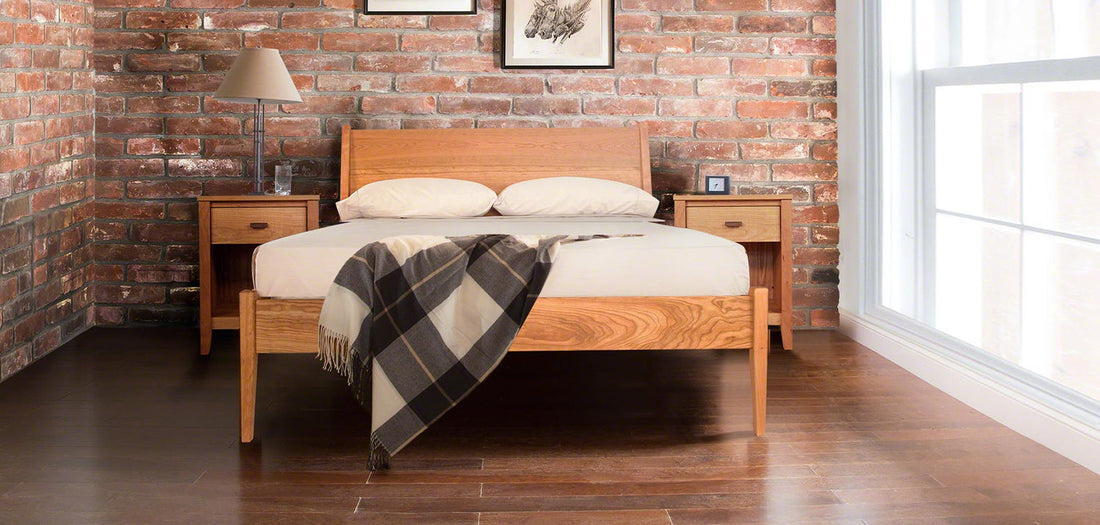Linseed oil, also known as flaxseed oil, is one of the most popular and time-tested wood finishes in the world. Like other hand-rubbed oil finishes, linseed oil penetrates deeply into the wood grain, protecting it from moisture, scratches, and changes in humidity. It’s known for producing a warm, satin finish that enhances the natural color and figure of the wood.
At Vermont Woods Studios, we often get questions about linseed oil and its role in traditional furniture finishing. As makers of handcrafted, solid wood furniture, we believe it’s important to understand how your furniture is made—and what finishes are used to protect it.
In this post, we’ll explain the three most common types of linseed oil used in woodworking.
What is Raw Linseed Oil?
Raw Linseed Oil is the purest, most natural form of the oil. It is the kind used in nutritional supplements and as a conditioner for leather (usually mixed with something to quicken curing time). Raw linseed oil makes a great finish for wood products if applied in thin coats and given plenty of time to cure, but it can take 2-10 weeks to fully dry depending on the environment and the thickness of the application.
Many craftsmen migrate toward polymerized or boiled linseed oil or some other alternative like tung oil if they don't have the patience or space to allow for ample drying time.
What is Polymerized Linseed Oil?
Polymerized Linseed Oil is created by heating raw linseed oil in the absence of oxygen to about 300°C (572°F) over the course of several days. During this process, a polymerization reaction occurs, which increases the oil’s viscosity and decreases the drying time. Both polymerized linseed oil and raw linseed oil contain zero VOCs (volatile organic compounds).
What is Boiled Linseed Oil?
Boiled linseed oil, often written as BLO, is not as it sounds– there’s no heating or boiling involved (unlike polymerized linseed oil). The difference between raw linseed oil and boiled linseed oil is that there are drying agents (either petroleum-based or heavy metals) added in order to make it a more feasible option for finishing wood furniture.
Some of the petroleum-based siccative compounds that are added to linseed oil to decrease the drying time are naptha, mineral spirits, and dipropylene glycol monomethyl. Cobalt and manganese are the most common metal siccatives found in boiled linseed oil.
Because of the drying compounds added to boiled linseed oil, it is the least food-safe of the three mentioned and emits some VOCs while drying. Boiled linseed oils often carry the following warning as required by the state of California:
“Warning: This product contains a chemical known to cause cancer and birth defects or other reproductive harm.”
Which Linseed Oil is Best for Wood Furniture?
| Type | Drying Time | VOCs | Food-Safe | Best For |
|---|---|---|---|---|
| Raw Linseed Oil | 2–10 weeks | No | Yes | Traditional finishes |
| Polymerized Linseed Oil | 1–2 days | No | Yes | Furniture, eco-conscious finishing |
| Boiled Linseed Oil (BLO) | 1–2 days | Yes | No | Quick jobs, non-food surfaces |
Whether you're a woodworker, furniture collector, or just looking to furnish your home with safe, sustainable pieces, knowing the difference between types of linseed oil is key to making informed choices. At Vermont Woods Studios, we're inspired by traditional woodworking methods and the timeless appeal of natural materials. Learning about finishes like linseed oil helps us—and our customers—appreciate the craft behind every piece just a little bit more.
Curious about how wood is finished or looking for a piece that celebrates its natural character? Explore our collection of oiled wood furniture, handcrafted by local artisans in Vermont.


